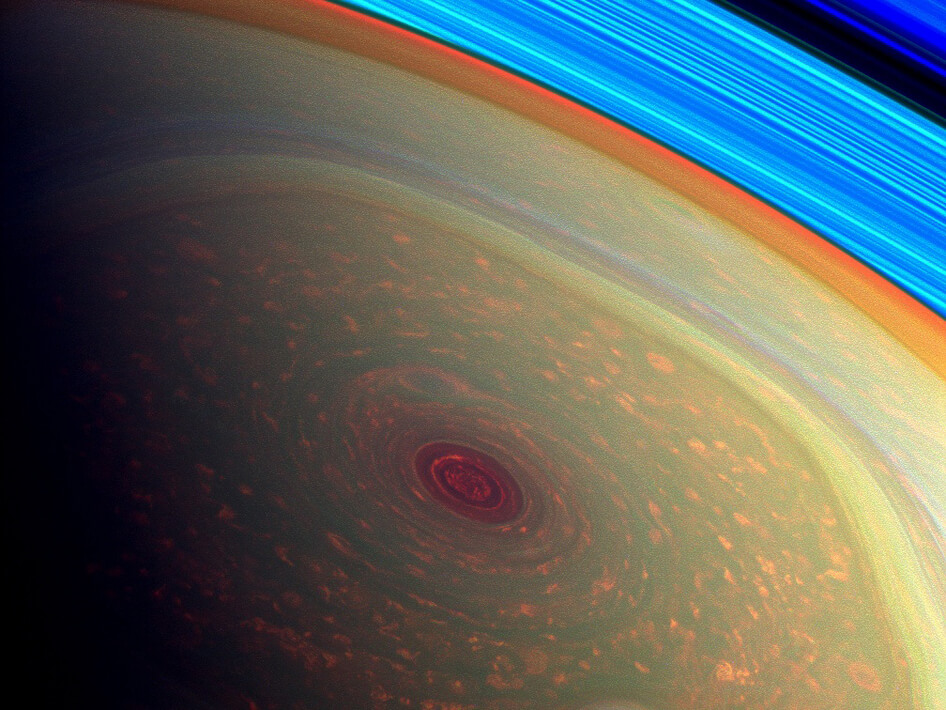NASA's Cassini spacecraft has provided scientists with the first close-up, visible-light image of a giant hurricane swirling around the planet Saturn's north pole.

NASA's Cassini spacecraft has provided scientists with the first close-up image seen for the first time, in visible light, of a giant hurricane swirling around the north pole of the planet Saturn.
In high-resolution images and videos, you can see that the width of the eye of the hurricane is about 20 km, which means it is 150 times larger than the average eye of the hurricane on Earth. Thin, bright clouds at the outer edge of the hurricane fly at a speed of XNUMX meters per second. The hurricane rotates within a hexagonal weather pattern.
"We did a double take when we saw this vortex because it looks so similar to hurricanes on Earth," said Andrew Ingersoll, a member of the Cassini imaging team at the Cal Institute of Technology in Pasadena. "But the hurricane on Saturn is on a much larger scale, despite the small amounts of water vapor in Saturn's hydrogen atmosphere."
http://www.youtube.com/watch?v=AmV6kPAPpQg
Video showing a hurricane-like storm at Saturn's north pole as captured by NASA's Cassini spacecraft.
Scientists want to learn about Saturn's hurricanes to gain insight into hurricanes on Earth, which feed the warm ocean water. Although there is no body of water close to these high-altitude clouds in Saturn's atmosphere, we can still learn from this about the behavior of hurricanes when they rise over continents.
Among the similar features when comparing terrestrial hurricanes on Earth and hurricanes on Saturn is that in both cases the storm includes high clouds that form the eye wall, other high clouds twist around the eye, and swirl counterclockwise in the Northern Hemisphere.
A major difference between the hurricanes is that the hurricane on Saturn is much larger than its counterparts on Earth and it rotates surprisingly quickly. On Saturn, the wind in the eyewall is four times faster than hurricane-force winds on Earth. Unlike terrestrial hurricanes, which tend to move, Saturn's hurricane is locked on the planet's north pole. On Earth, hurricanes tend to drift north due to the forces acting on the wind eddies due to the speed of rotation of the Earth and on Saturn there is nowhere to drift. It is as far north as possible.
"The polar hurricane has nowhere else to go, and that's likely why it's stuck at the pole," said Kunio Sayanagi, a Cassini imaging team associate at Hampton University in Virginia.
The scientists believe that the massive storm has been raging for years. When the Cassini spacecraft arrived in the Saturn system in 2004, Saturn's north pole was dark because the planet was in the middle of winter in the northern hemisphere. During this time, Cassini's Combined Infrared Spectrometer and Visual and Infrared Mapping Spectrometer detect a large vortex, but the visible-light view had to wait until the equinox in August 2009. Only then did sunlight begin to flood Saturn's northern hemisphere. The display required a change in the angle of Cassini's orbits around Saturn so that it could see the poles.
“What an amazing and mesmerizing view of the hurricane-like storm at the North Pole. This view is only possible because Cassini switched to a sporty orbit, with loops above and below Saturn's equatorial plane," said Scott Edgington, Cassini deputy program manager and scientist at NASA's Jet Propulsion Laboratory in Pasadena, Calif. "The polar regions cannot be seen well from an equatorial orbit. . Just as observing the Earth from different vantage points reveals more about the layers of clouds that cover the Earth."
Cassini changes its orbital inclination for polar operations only once every few years. This is because the spacecraft is assisted by approach flights to the moon Titan to change the angle of its orbit, and this requires close supervision and navigation. The path requires years of careful planning in advance. Sticking to the planned orbit is intended to ensure enough fuel is available for the spacecraft to reach planned orbits and future rendezvous.

4 תגובות
Scientists marvel at Saturn's polar cyclone but don't pay enough attention to the Antarctic mini-cyclone on Earth. If it weren't for this attention, they wouldn't be so surprised that Saturn's polar cyclone doesn't move, a subtle hint of Coriolis. Another hint, the movement of the global winds on the surface of the earth is in an outline close to the latitude lines (if that is the exact name), meaning the outline parallel to the equator (I don't know if near the equator on the earth there is wind movement in a preferred direction, except above it upwards).
Nte
The hexagon is not absurd. It is possible that there are some obstacles in the atmosphere of Saturn near the poles that prevent the airflow from moving in a perfect circular motion, in this situation the flow can settle in an intermediate outline between a circle and an elaborate polygon. Of the elaborate polygons that come into consideration, it is possible that in the specific case of Saturn, the hexagon is the closest to a steady state of flow. It is possible that the obstacles at the same location were different - - - a steady flow of air was on a route close to an elaborate pentagon or an elaborate octagon or a watbar.
This hexagon is completely absurd. I wonder what the laws of physics are behind it